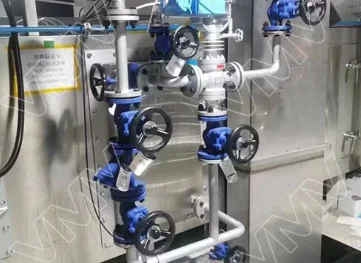Wastewater treatment is a complex and vast undertaking, requiring the coordinated efforts of multiple parties to achieve a successful outcome. Within wastewater piping systems, there’s a crucial yet often overlooked component: valves.

Numerous valves are used to treat wastewater. Fluids of varying volumes pass through various types of valves, undergoing a series of processing steps to transform waste into valuable resources, safeguarding the very foundations of our lives. So, what are the valves that are the “heroes” of wastewater treatment?
Ball Valves
The sealing surfaces of ball valves are often made of corrosion-resistant materials such as polytetrafluoroethylene (PTFE), ensuring a strong seal in a variety of media. In wastewater treatment, whether operating in high-temperature, high-pressure environments or with highly corrosive media, this excellent sealing performance effectively prevents wastewater leakage, ensuring operational safety and protecting the environment.
Ball valves are easy to operate, allowing for quick opening and closing with a simple 90-degree turn. This critical feature allows for rapid response to changing system requirements. For example, in emergencies, they can quickly shut off or release fluids, improving system response speed and operational flexibility.
When fully open, the gate valve creates a straight-through flow path with minimal flow resistance and no dead zones. It is particularly suitable for wastewater containing high levels of suspended solids, sludge, or scum, effectively preventing clogging and entanglement.
The wedge-shaped or serrated sealing surfaces between the gate disc and the valve seat effectively eliminate the effects of impurities on sealing performance, maintaining a stable seal even in media containing impurities such as silt and fiber.
Nominal diameters range from 50–1500 mm, and operating pressures range from 1–4 MPa, meeting the flow and pressure requirements of various scales, including municipal and industrial wastewater.
Gate valves offer a simple structure with few components and are available with either rising or concealed stems, and manual or electric opening and closing options, facilitating maintenance and automated control, reducing long-term operational costs.
In wastewater treatment systems, when a pump stops operating, the pressure in the pipeline drops, and the check valve automatically closes, preventing wastewater backflow from damaging the pump or clogging the pipeline. This is critical for ensuring the normal operation of equipment such as pumps, reducing equipment repair and replacement costs, and improving the reliability and stability of the entire treatment system.
Plug Valve
The plug of a plug valve easily switches between two-way, three-way, and even four-way positions. A single valve can perform media distribution, diversion, and bypass operations, significantly reducing the number of valves and fittings in a piping system, lowering the risk of leaks and maintenance costs.
The plug valve’s sealing surface acts as a wiper during opening and closing, effectively dislodging solid particles, sludge, or fibers in the wastewater from the sealing area, preventing particle embedment and seal failure. It is particularly suitable for wastewater conditions with high suspended solids content.
Modern globe valves can be integrated with intelligent sensors and actuators to enable remote monitoring and automatic control. In automated wastewater treatment systems, remote monitoring and automatic control capabilities allow for real-time adjustment of the globe valve opening based on actual wastewater treatment conditions, improving operational efficiency, reducing human error, and enhancing system safety and reliability.
Globe valves are designed with fluid dynamics in mind to minimize pressure loss during fluid flow, thereby reducing the energy required to pump the fluid. Wastewater treatment consumes significant amounts of energy to pump wastewater. The energy-saving design of globe valves is crucial for reducing energy consumption and greenhouse gas emissions, aligning with environmental protection and sustainable development.
Globe valves can be customized to meet the needs of different wastewater treatment projects, adapting to varying fluid media, pressure, and temperature conditions. Wastewater from different sources varies significantly in properties and treatment processes. This flexibility enables globe valves to excel in a variety of wastewater treatment scenarios.
Summary
In addition to the five valves mentioned above, other valves are used in wastewater treatment, which we will not discuss in detail here. If you are interested in this topic, please contact us. Newton will provide you with professional answers and the highest quality valves.

